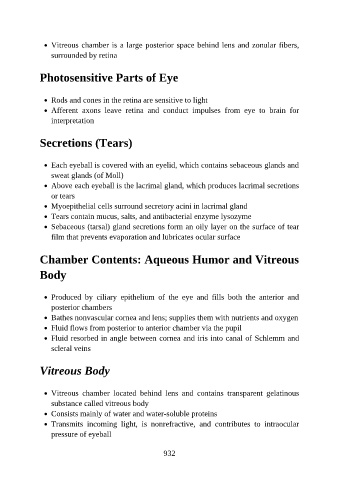Page 933 - Atlas of Histology with Functional Correlations
P. 933
Vitreous chamber is a large posterior space behind lens and zonular fibers,
surrounded by retina
Photosensitive Parts of Eye
Rods and cones in the retina are sensitive to light
Afferent axons leave retina and conduct impulses from eye to brain for
interpretation
Secretions (Tears)
Each eyeball is covered with an eyelid, which contains sebaceous glands and
sweat glands (of Moll)
Above each eyeball is the lacrimal gland, which produces lacrimal secretions
or tears
Myoepithelial cells surround secretory acini in lacrimal gland
Tears contain mucus, salts, and antibacterial enzyme lysozyme
Sebaceous (tarsal) gland secretions form an oily layer on the surface of tear
film that prevents evaporation and lubricates ocular surface
Chamber Contents: Aqueous Humor and Vitreous
Body
Produced by ciliary epithelium of the eye and fills both the anterior and
posterior chambers
Bathes nonvascular cornea and lens; supplies them with nutrients and oxygen
Fluid flows from posterior to anterior chamber via the pupil
Fluid resorbed in angle between cornea and iris into canal of Schlemm and
scleral veins
Vitreous Body
Vitreous chamber located behind lens and contains transparent gelatinous
substance called vitreous body
Consists mainly of water and water-soluble proteins
Transmits incoming light, is nonrefractive, and contributes to intraocular
pressure of eyeball
932

